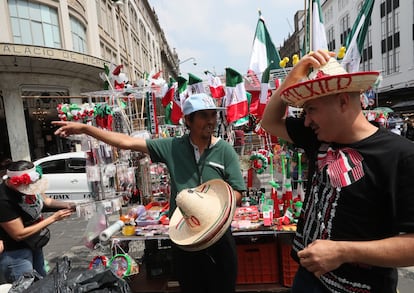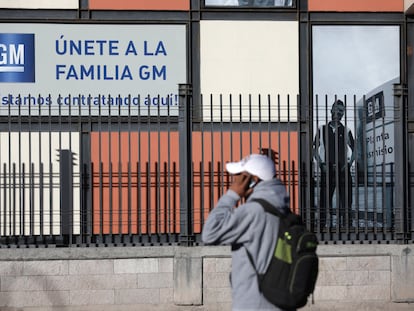In Mexico City’s Zócalo square, Independence Day ‘is the best day of the year to sell’
Street vendors are only a small portion of the people who will benefit from the revenue generated by the celebrations, expected to be 12% more than in 2022


On September 15, the area around the Zócalo in Mexico City is festooned with the colors green, white and red. The national flag is present in all kinds of paraphernalia: headbands, fighter masks, earrings, huipiles, hats and much more. For the merchants who sell these items in the streets near the capital’s most important square, the eve of Independence Day is the best day for sales. The business made by these retailers represent a small portion of the 23 billion pesos ($1.35 billion) that the national holiday will generate this year, 12% more than in 2022, according to the Confederation of National Chambers of Commerce, Services and Tourism.
On a corner of 5 de Mayo Street, which commemorates the Mexican victory over the French in the Battle of Puebla in 1862, hundreds of people walk at midday in search of the entrance to the Zócalo. Guillermo, 20, has his stand there, explaining that for three decades it has been passed down from generation to generation. “The 15th is the best day to sell objects with the Mexican flag,” he says while waiting on a bench for customers to arrive. The star product this year is a stuffed animal representing the president, Andrés Manuel López Obrador, which some of the visitors to the historic center carry under their arms.
Across the sidewalk, Mexican flags are sold for 450 pesos, earrings for 15 and headbands for 60. The seller is Jocelyn Gracián, 18, who comes to set up her stall on this street daily from Santa Ana Jilotzingo, in the State of Mexico. She is part of the floating population that takes hours every day to reach the capital from the periphery. “I’m only here in September, it’s a month when everyone wants to buy decorations related to Mexico,” she explains.
Pablo Celestino, 44, has his stall on 16 de Septiembre Street, the best location to sell objects with the three colors because the street name alludes to the exact date of Mexico’s independence from Spain. He paid about 2,500 pesos to have his piece of sidewalk from September 1st until this Saturday, when he will collect “what is left over” and return to his home in Toluca, in the State of Mexico. Regarding work hours, he explains that he has been there since 9 a.m. and will leave “around 8:30 p.m., before thousands of people crowd the Zócalo and the roads that leave it.
On the same street, in the background, you can hear a cumbia that a young man with an accordion is playing with notes that are reminiscent of corridos tumbados, a Mexican musical subgenre that is sweeping the world. A cap on the floor serves as a container for coins and bills, since music is also part of the business that is created these days around the Zócalo.
On Francisco I. Madero Avenue, the only authorized entrance to the square, there is a group of six people with instruments performing Cielo Azul, Cielo Nublado, by Grupo Pesado. Around them, two women offer mustaches for 10 pesos and headbands for 20. They are part of that 55% of people who work informally throughout the country, according to the National Occupation and Employment Survey in June. This Tuesday, around the Zócalo, many people were selling products that were hanging from their arms, without an official sales stand.
Inside the square, under the giant Mexican flag that dominates the center of the Zócalo, are the fences separating thousands of people from the balcony of the National Palace, where López Obrador was expected at 11:00 p.m. Leaning on one of them is Graciela Zepeda, who has been there since 5:00 a.m.. “We came to see the president up close,” she says. She has come from Mexicali, in the State of Baja California, and will spend two days in Mexico City. She is with Claudia Páez, a Colombian woman who has lived in Guanajuato for seven years and who also came for the 2022 celebrations. María Miranda is from Guadalajara, but she has come here from Los Angeles, where she lives, saying she has spent “$700 dollars to see the president cry El Grito.”
Sign up for our weekly newsletter to get more English-language news coverage from EL PAÍS USA Edition
Tu suscripción se está usando en otro dispositivo
¿Quieres añadir otro usuario a tu suscripción?
Si continúas leyendo en este dispositivo, no se podrá leer en el otro.
FlechaTu suscripción se está usando en otro dispositivo y solo puedes acceder a EL PAÍS desde un dispositivo a la vez.
Si quieres compartir tu cuenta, cambia tu suscripción a la modalidad Premium, así podrás añadir otro usuario. Cada uno accederá con su propia cuenta de email, lo que os permitirá personalizar vuestra experiencia en EL PAÍS.
¿Tienes una suscripción de empresa? Accede aquí para contratar más cuentas.
En el caso de no saber quién está usando tu cuenta, te recomendamos cambiar tu contraseña aquí.
Si decides continuar compartiendo tu cuenta, este mensaje se mostrará en tu dispositivo y en el de la otra persona que está usando tu cuenta de forma indefinida, afectando a tu experiencia de lectura. Puedes consultar aquí los términos y condiciones de la suscripción digital.
More information
Archived In
Últimas noticias
Welcome to the post-religion era: The idea of Christianity as the absolute truth has become obsolete
‘I thought you would like it’: The risky sexual practice popularized by TV shows and TikTok
The digitalization of tourism: ‘They promise experiences and gave us the worst possible one’
Mexican peso defies uncertainty with forecasts of a new period of stability in 2026
Most viewed
- Sinaloa Cartel war is taking its toll on Los Chapitos
- Reinhard Genzel, Nobel laureate in physics: ‘One-minute videos will never give you the truth’
- Oona Chaplin: ‘I told James Cameron that I was living in a treehouse and starting a permaculture project with a friend’
- Why the price of coffee has skyrocketed: from Brazilian plantations to specialty coffee houses
- Silver prices are going crazy: This is what’s fueling the rally










































